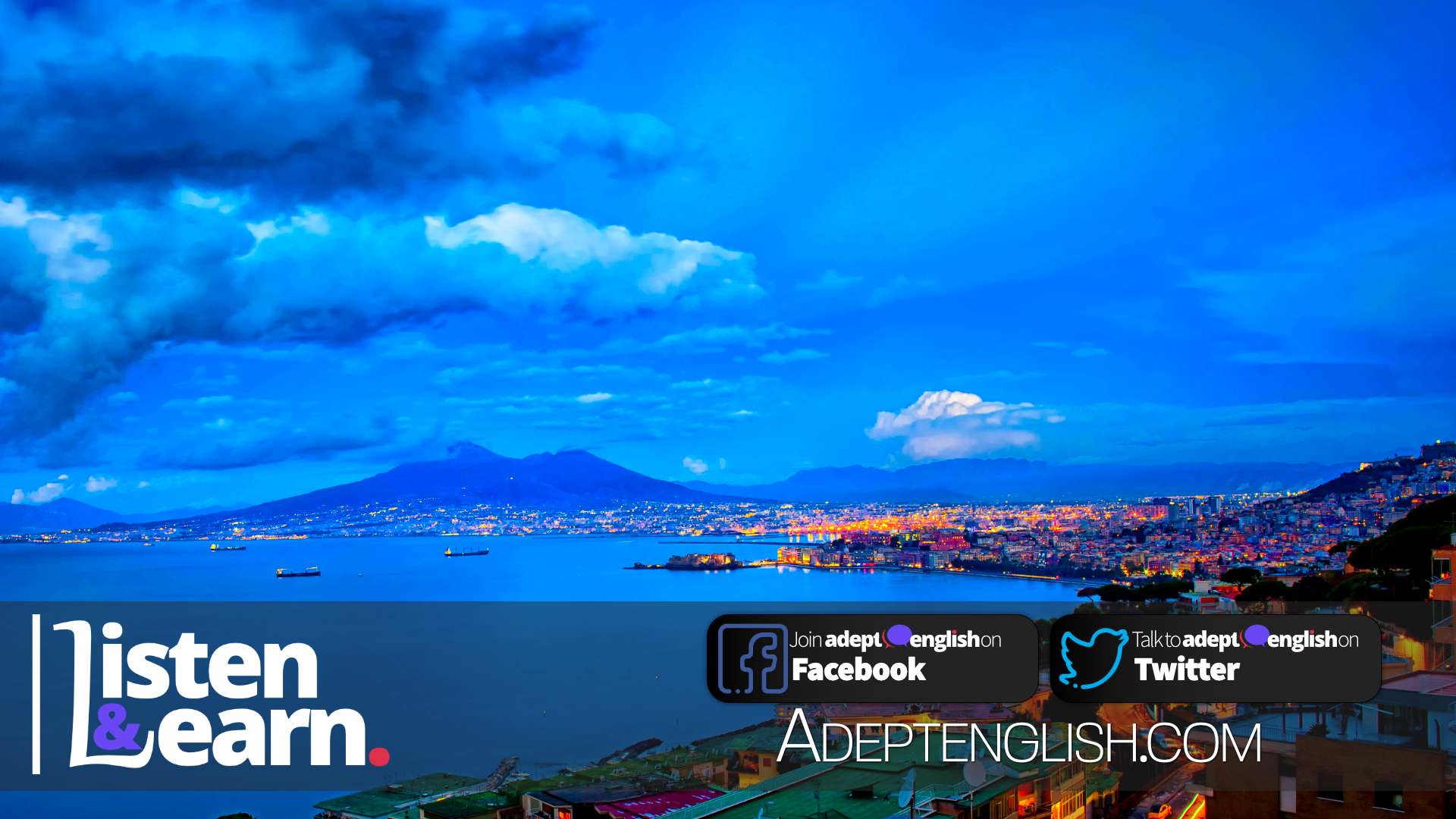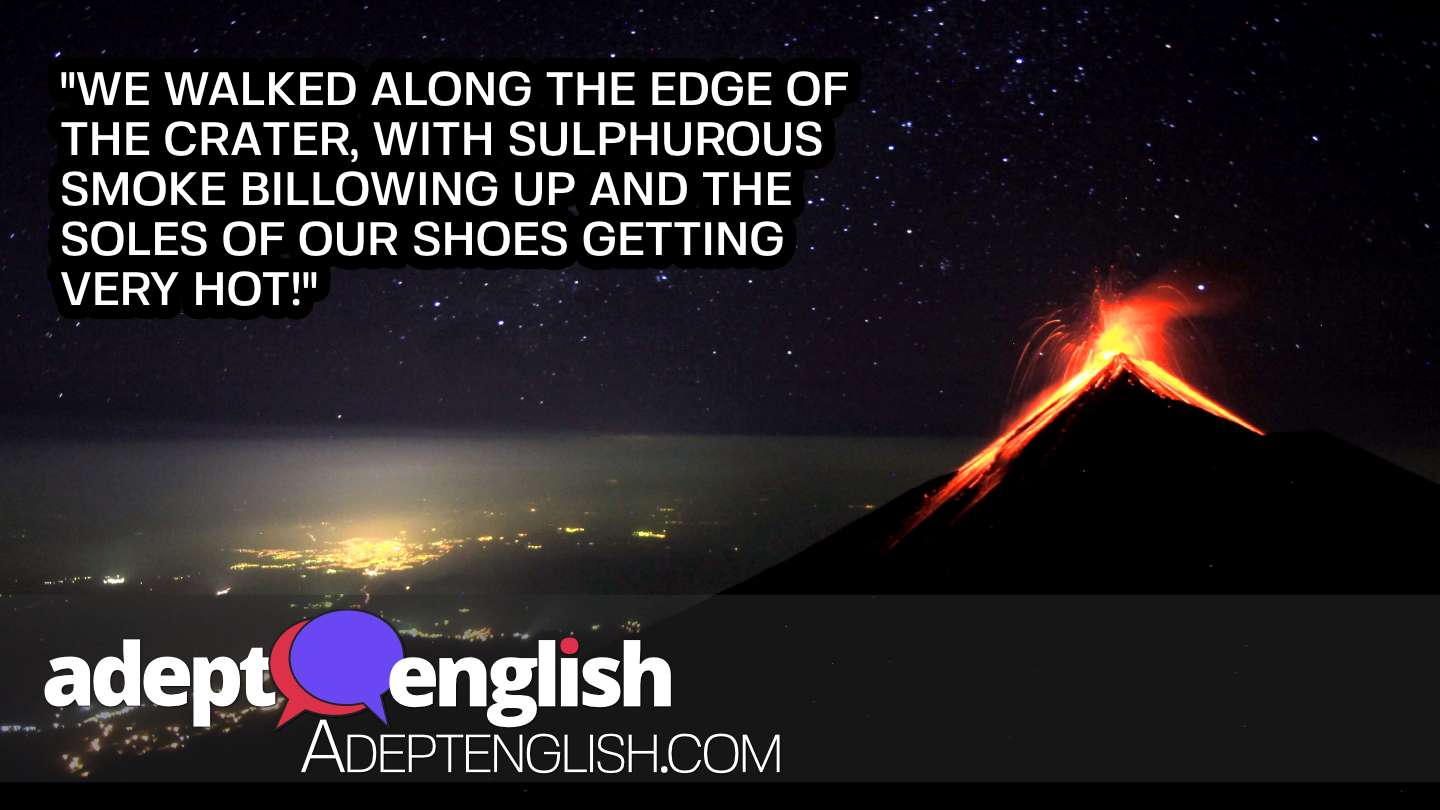Hot Conversation With English Listening Practice
We have many interesting geological structures in the UK, but we are missing one. The UK has no active volcanos, thank goodness. However, you don’t have to travel far to find volcanos and today we are going to discuss this as our English listening practice topic.
The closest active Volcano to the UK is Katla in Iceland, which is 500+ miles from the farthest northern part of the UK. Which is the Isle of Lewis.
Vesuvius, the volcano we will talk about today, is nearly a 1000 miles from the furthest southern part of the UK. The most southern part of the UK is the Channel Islands. However, this volcano popped up on the BBC news recently. Having visited with my mother long ago, I thought it would be an excellent topic for discussion in today’s English listening practice lesson.
Adept English helps English language students to improve their spoken English through repeat listening. To help keep students engaged in listening, we often talk about interesting and contemporary topics. You can learn more about our system of learning to speak English here.
You might not be interested in volcanos, but there is so much more going on in this English listening lesson. Lots of vocabulary, training your brain to hear and comprehend English being spoken by a native English speaker. You will listen to English idioms everyday English conversation that you would expect to hear in any part of the UK right now in 2021. So listen to this lesson several times and get training your brain to understand spoken English automatically.
Most Unusual Words:
Lava
Volcano
Dynamite
Eruption
Pyroclastic
Molten
Crater
Most common 3 word phrases:
| Phrase | Count |
|---|---|
| Of Enjoying The | 2 |
| The Seven Rules | 2 |
| The Lava Flow | 2 |
Listen To The Audio Lesson Now
The mp3 audio and pdf transcript for this lesson is now part of the Adept English back catalogue . You can still download and listen to this lesson as part of one of our podcast bundles.Transcript: Volcanos and Lava In A Conversation With English Listening Practice
Hi there and welcome to this latest podcast from Adept English. Do you like our podcasts? Lots of people do and we’ve got more people listening to the Adept English podcast than ever before! Tell your friends about us – see if we can ‘spread the word’.
And if you haven’t yet done our free course, The Seven Rules of Adept English – it would be a really good idea! You can sign up for the Seven Rules course on our website at adeptenglish.com – and learn how to use these podcasts in the best possible way to help your English language learning.
Boost Your Learning With Adept English
Shall we stretch your vocabulary in a particular direction today? Let’s go for a topic, something that’s current, which will introduce some words in English, that you may not have seen or heard or used before. You’ll have these words in your own language of course, but let’s give this topic a whirl in English.
Mount Etna has erupted
So in the news recently – Mount Etna has erupted. As you probably know, Mount Etna, ETNA is a volcano located in Sicily and Mount Etna is Europe’s tallest active volcano at 3,320 metres high. The verb ‘to erupt’, ERUPT means ‘to burst forth, to release something, possibly violently’.
So someone might ‘erupt with anger’ if they were really annoyed, but with Mount Etna, it’s a very literal ‘eruption’ – volcanic lava and smoke is pouring out. In fact, volcanic lava was spouting 1,500 metres into the air a few weeks ago. That’s dramatic and spectacular to watch – so Sicilians, the inhabitants of Sicily, were posting videos of Etna on social media. What makes this volcanic eruption different perhaps – there’s less threat, less risk posed by Etna than by many volcanoes.
Eruptions are fairly frequent, but they don’t usually pose a risk to life or to property. This means that there’s more possibility of enjoying the light show, of enjoying the spectacle without worrying about lives or livelihoods being lost. One interesting statistic - Etna has claimed the lives of only 77 people in the last 2,000 years. The lava, that’s LAVA flows quite slowly, so it’s easy to get out of its way.
Video
Mount Etna’s big eruption - 1983
Etna is not a zero threat, of course – it’s still an active volcano. For example, the hotel and restaurant La Cantoniera, which is very close to Etna was destroyed in 1983 and rebuilt in 1985, so it’s still there. There are people who live with Etna as a constant threat.
On that occasion in 1983, the volcano erupted on 28th March, destroying buildings nearby, including La Cantoniera, but the lava flow was slow – and it took nearly a month until late April, for the lava stream to extend to four miles long. This slow progress meant that it was possible to divert the lava flow – to alter its path, its course, so that towns could be saved from the lava.
Dynamite, that’s DYNAMITE - explosive was used to create a channel for the lava to flow down – and high barriers were constructed to prevent the lava from threatening nearby towns. The lava then ‘froze’ in those channels when it cooled down. And this saved lives, buildings, livelihoods – that means somebody’s business, their way of ‘make a living’, and the cost of rebuilding. So Sicilians nearby live with the threat of Etna – but the fear is moderated a little.
My volcano experience – touring Italy!
My volcano experience? Well, as I studied Latin at university for my first degree – I was interested in all things classical. So the archaeological sites at Pompeii and Herculaneum in Italy were of great interest to me – still are! And of course these are located on the Italian mainland, under the shadow of the great volcano, Vesuvius. I visited these sites, when I was a student – and the volcano with my mother.
📷
A photograph of a volcano erupting near a city at night. A hot English listening practice lesson about lava and volcanos.
We walked along the edge of the crater, with sulphurous smoke billowing up and the soles of our shoes getting very hot! ‘Crater’ is spelt CRATER – and it means the big hole left when a volcano erupts – the centre of the volcano, which is usually like a hole in the top of the mountain. I remember being amazed to see houses built so close to an active volcano. And Pompeii and Herculaneum are fantastic places to visit, if you get the chance. They’re towns, perfectly preserved, which tell us a lot about life in 79AD. They’re really fascinating.
Vesuvius is active and a risk
So Vesuvius is a threatening volcano. In fact if you google ‘What is the most dangerous volcano in the world?’ - Vesuvius is the answer which comes back. Unlike Etna, Vesuvius has taken thousands and thousands of lives across the ages. But Vesuvius is a place worth visiting – it’s amazing to see it and you’d be unlucky if it happened to erupt, just as you were there! But for thousands of people who live near Vesuvius, it’s more of a threat.
The large city of Naples is only 12km away and there are plenty of smaller villages and towns nearby. If you look at an aerial photograph of it, Vesuvius, you see how densely populated the area is – just how many people live there. Most of the time, lava flow is fairly slow – you can outrun it – that means you can run faster than the lava travels. But the flow is difficult to stop and it slowly destroys whatever is in its path. Lava flows reaching speeds of 50mph have been known historically – so there is potential for loss of life, if Vesuvius were to have a sudden, big eruption.
In fact, scientists are still studying exactly how people in Pompeii and Herculaneum died in the 79AD eruption. Many seem to have died from very high temperatures, possibly what’s called a ‘pyroclastic surge’ – a sudden, high air temperature. Scientists are hoping to learn from this study, so that they can protect people living near Vesuvius in the present day.
Vesuvius in 79AD and 1944
The last big eruption of Vesuvius was March 17th 1944 and 26 people died. Most of these people died because the weight of volcanic ash on the rooves of houses made them collapse. But this eruption caused thousands of people to lose their homes and their livelihoods as lava consumed the town of San Sabastiano.
Download The Podcast Audio & Transcript
In the 79AD eruption of Vesuvius, which was documented by the Roman writer Pliny the Younger, it’s estimated as many as 30,000 people died. It’s not known when Vesuvius will erupt again and of course, there is much more scientific understanding these days than there was in past times, so hopefully there would be adequate warning.
Vesuvius is the volcano to be worried about perhaps, while Mount Etna poses a relatively small threat – and we can enjoy the spectacle, knowing that it’s unlikely that anyone is going to die or lose their homes.
Summary of volcanological vocabulary!
A quick summary of that volcanological vocabulary?! Volcano, VOLCANO – that’s like Vesuvius and Etna. And lava, LAVA – that’s the molten rock which flows out. ‘To erupt’ and ‘an eruption’ – that’s what a volcano does from time to time. And a crater, CRATER is the hole in the middle of a volcano.
Goodbye
Enough for now. Have a lovely day. Speak to you again soon. Goodbye.







